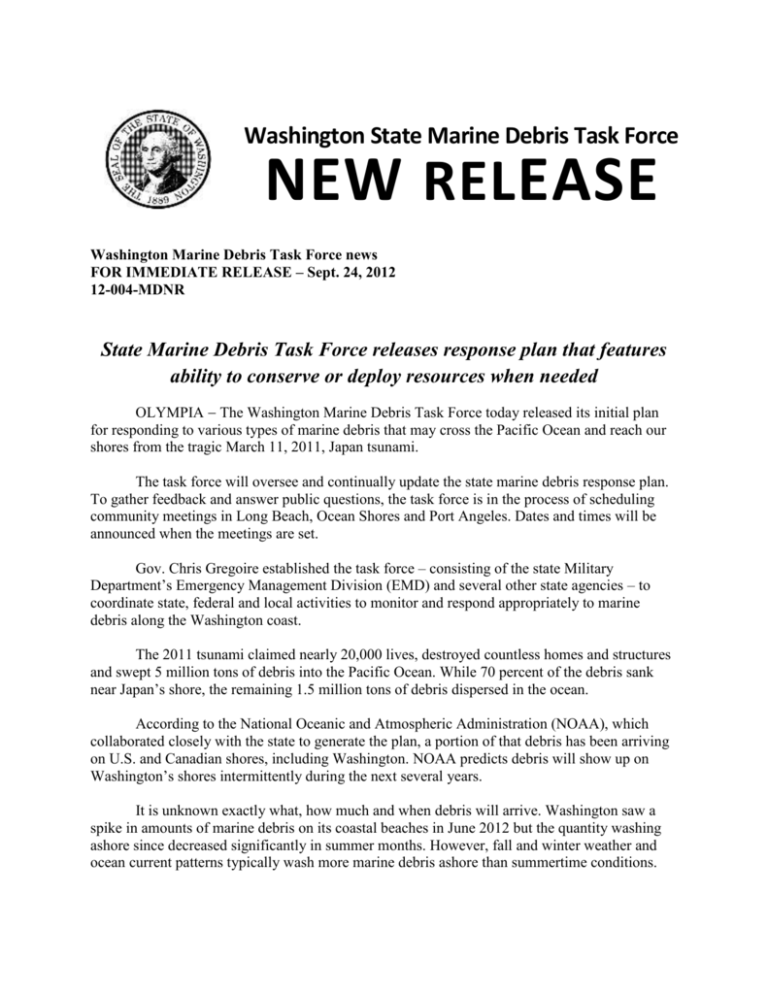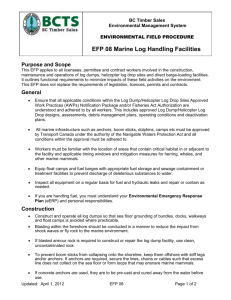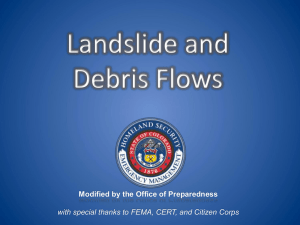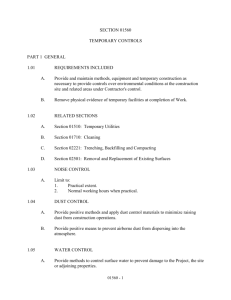Washington Marine Debris Task Force news
advertisement

Washington State Marine Debris Task Force NEW REL EASE Washington Marine Debris Task Force news FOR IMMEDIATE RELEASE – Sept. 24, 2012 12-004-MDNR State Marine Debris Task Force releases response plan that features ability to conserve or deploy resources when needed OLYMPIA The Washington Marine Debris Task Force today released its initial plan for responding to various types of marine debris that may cross the Pacific Ocean and reach our shores from the tragic March 11, 2011, Japan tsunami. The task force will oversee and continually update the state marine debris response plan. To gather feedback and answer public questions, the task force is in the process of scheduling community meetings in Long Beach, Ocean Shores and Port Angeles. Dates and times will be announced when the meetings are set. Gov. Chris Gregoire established the task force – consisting of the state Military Department’s Emergency Management Division (EMD) and several other state agencies – to coordinate state, federal and local activities to monitor and respond appropriately to marine debris along the Washington coast. The 2011 tsunami claimed nearly 20,000 lives, destroyed countless homes and structures and swept 5 million tons of debris into the Pacific Ocean. While 70 percent of the debris sank near Japan’s shore, the remaining 1.5 million tons of debris dispersed in the ocean. According to the National Oceanic and Atmospheric Administration (NOAA), which collaborated closely with the state to generate the plan, a portion of that debris has been arriving on U.S. and Canadian shores, including Washington. NOAA predicts debris will show up on Washington’s shores intermittently during the next several years. It is unknown exactly what, how much and when debris will arrive. Washington saw a spike in amounts of marine debris on its coastal beaches in June 2012 but the quantity washing ashore since decreased significantly in summer months. However, fall and winter weather and ocean current patterns typically wash more marine debris ashore than summertime conditions. The state plan is designed to coordinate rapid responses to marine debris of significant impact – particularly items that are large, contain hazardous substances such as oil or toxic chemicals, or pose invasive species concerns. The plan is available at http://marinedebris.wa.gov/docs/responseplan_marinedebris_09182012.pdf EMD’s Terry Egan, the state’s marine debris task force lead, said: “The state marine debris response plan anticipates that incidents involving debris with high impact will be unique and impossible to predict. The plan is designed to give local, tribal, state and federal responders flexibility in rapidly assessing a debris item and identifying which agencies will respond and what resources will be needed to protect public health, safety and the environment.” The plan also is tailored to address the steady response to a potential influx of more routine, nonhazardous debris by supporting ongoing local community efforts – traditionally undertaken by dedicated volunteers – to remove these items. Since no state, federal or local entity has the funding, authority or responsibility to remove nonhazardous debris from Washington’s coastal beaches, the plan calls for supporting these beach cleanup efforts, such as providing volunteers gloves, litter bags and access to trash bins. Numerous entities manage Washington’s 375 miles of coastal beaches. These include Native American tribes, Hoh Indian Tribe, Makah Nation, Quileute Indian Tribe, Quinault Indian Nation, Shoalwater Bay Tribe; federal government entities Olympic National Park, U.S. Fish & Wildlife Service, Olympic Coast National Marine Sanctuary; and the Washington State Parks and Recreation Commission. Egan said the state response plan is a “living document” that will be refined over time. “We will continue coordinating with our local communities to ensure that our response efforts meet the needs of each community – including the dedicated citizen volunteer groups that have helped keep our beaches clean for decades,” Egan said. “This is the best way we can ensure that our limited resources get out to the right places at the right times.” Ocean Shores Mayor Crystal Dingler said: “The City of Ocean Shores and other coastal communities deeply appreciate the proposed help and guidance from Gov. Gregoire and the task force. As wonderful and necessary as our local and visitor volunteer efforts are, possible large deposits of debris or large debris items will be an incredible challenge for our community. We look forward to the planned regional meetings and trust that with the flexibility built into the state’s program, we will be able to deal with possible debris events.” Agencies poised to respond Citizens can help keep our coastal beaches clean by removing and disposing of small nonhazardous items such as plastic bottles and floats, Styrofoam, pieces of lumber, crates and other small moveable objects wherever possible. However, anyone who encounters potentially hazardous debris should not touch or attempt to move it. Instead people should immediately call the state’s 1-855-WACOAST (1-855922-6278) number and press “1” to reach an operator who can dispatch responders. The Washington Department of Ecology, U.S. Coast Guard, or U.S. Environmental Protection Agency will respond to any petroleum products or other hazardous materials that wash up on our beaches. Items to watch out for include spilled oil, drums and barrels, fuel tanks, gas cylinders, chemical totes and other containers with unknown fluids. The Washington Department of Fish and Wildlife will respond to invasive species concerns. The department anticipates marine debris with invasive species attached will be rare and limited to large structures that spend a long time in their native waters such as boats, docks, navigation aids and breakwaters. People may find organisms attached to other items – sometimes in heavy accumulations – but these will be common open ocean species such as pelagic gooseneck barnacles. For more, see www.wdfw.wa.gov/tsunami/. The Washington Department of Health (Health) radiation will respond to any debris marked with words or symbols indicating it may be radioactive. Health experts do not expect to find any marine debris with elevated radiation levels. Earlier tests on debris items revealed only expected low, background levels of radiation. For more information, go to www.doh.wa.gov/Emergencies/EmergencyPreparednessandResponse/FukushimaUpdate/Tsun amiDebrisFAQ.aspx. More about marine debris, including potential tsunami debris In July 2012, the task force launched a toll-free reporting line citizens can use to call in potentially hazardous and other debris, 1-855-WACOAST (1-855-922-6278). The Washington marine debris web portal is http://marinedebris.wa.gov/. NOAA remains the best source for information about Japan tsunami marine debris including modeling, protocols to follow for handling marine debris and frequently asked questions. Go to http://marinedebris.noaa.gov/tsunamidebris/ NOAA is actively collecting information about tsunami debris and asks the public to report debris sightings to DisasterDebris@noaa.gov. Please include the time, date, location and, if possible, photos in such reports. Don’t burn driftwood. Salt residue from ocean waters stays in pores of the wood, even after it’s dry. According to Ecology, when burned the chlorine reacts with the wood to form toxic compounds called dioxins that are released in the smoke. Such compounds can affect the immune system. If a beach fire is permitted, bring seasoned, non-driftwood, and enjoy. State Parks asks people who want to clean debris from beaches to focus on small, nonnatural items such as Styrofoam and plastic. Leave wood and kelp because these are an important part of the beach ecosystem. Stripping the beach of its driftwood depletes needed coastal habitat. According to state law, it is illegal to burn garbage, and construction and demolition debris. More at http://apps.leg.wa.gov/RCW/default.aspx?cite=70.94.6512. ### Media contacts: Linda Kent, Washington Ecology media relations, 360-407-6239, cell, 360-791-9830; linda.kent@ecy.wa.gov Curt Hart, Washington Ecology media relations, 360-407-6990; cell, 360-480-7908; curt.hart@ecy.wa.gov For more information: Washington Marine Debris web portal: http://marinedebris.wa.gov NOAA: http://marinedebris.noaa.gov/tsunamidebris/ Joint States tsunami debris information website: http://disasterdebris.wordpress.com/ Washington Emergency Management Division: http://www.emd.wa.gov/index.shtml Washington Department of Health: http://www.doh.wa.gov/Emergencies/EmergencyPreparednessandResponse/ FukushimaUpdate/TsunamiDebrisFAQ.aspx Washington Department of Fish and Wildlife: http://www.wdfw.wa.gov/tsunami/ Washington Department of Ecology: http://www.ecy.wa.gov/programs/spills/spills.html Washington State Parks and Recreation Commission: http://www.parks.wa.gov/ Washington State Conservation and Recreation Office: http://www.rco.wa.gov/






